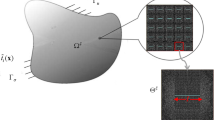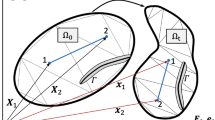Abstract
A homogenization-based phase-field method is introduced to systematically investigate fracture behavior of heterogeneous materials in this research. The construction of a homogeneous medium equivalent to a heterogeneous one is fulfilled by employing different homogenization methods. In this way, the fracture response of heterogeneous materials can be obtained by fracture analysis of homogeneous materials. On the one hand, the proposed method provided a new technique to study the influence of mesoscopic information of heterogeneous materials on its macroscopic fracture behavior. On the other hand, the fine meshing required for directly solving the fracture problem of heterogeneous materials can be avoided. The proposed technique can reproduce both the mechanical force response and crack path with good accuracy. In the numerical examples, the effect of mesoscopic information of periodically heterogeneous material and porous medium on their fracture behavior is investigated in detail. Results show that the proposed method is efficient and reliable and has the potential in fracture analysis of heterogeneous materials.



























Similar content being viewed by others
Data availability
Data and results will be made available upon reasonable requests.
References
LeBlanc, J., Shukla, A., Rajapakse, Y.D.S.: Dynamic failure of composite materials. J. Dyn. Behav. Mater. 4(3), 257–257 (2018). https://doi.org/10.1007/s40870-018-0171-5
Zhang, P., Hu, X., Bui, T.Q., Yao, W.: Phase field modeling of fracture in fiber reinforced composite laminate. Int. J. Mech. Sci. 161–162, 105008 (2019). https://doi.org/10.1016/j.ijmecsci.2019.07.007
Lancioni, G., Alessi, R.: Modeling micro-cracking and failure in short fiber-reinforced composites. J. Mech. Phys. Solids 137, 103854 (2020). https://doi.org/10.1016/j.jmps.2019.103854
Li, J., Zong, B.Y., Wang, Y.M., Zhuang, W.B.: Experiment and modeling of mechanical properties on iron matrix composites reinforced by different types of ceramic particles. Mater. Sci. Eng. A 527(29–30), 7545–7551 (2010). https://doi.org/10.1016/j.msea.2010.08.029
Bourdin, B., Francfort, G.A., Marigo, J.J.: Numerical experiments in revisited brittle fracture. J. Mech. Phys. Solids 48(4), 797–826 (2000). https://doi.org/10.1016/S0022-5096(99)00028-9
Francfort, G.A., Marigo, J.J.: Revisiting brittle fracture as an energy minimization problem. J. Mech. Phys. Solids 46(8), 1319–1342 (1998). https://doi.org/10.1016/S0022-5096(98)00034-9
Wu, J.Y., Nguyen, V.P., Nguyen, C.T., Sutula, D., Sinaie, S., Bordas, S.: Phase-field modelling of fracture. Adv. Appl. Mech. 53, 1–183 (2020). https://doi.org/10.1016/bs.aams.2019.08.001
Yuan, J.H., Mao, Y.Q., Chen, C.P.: Multiple-phase-field modeling for fracture of composite materials. Mech. Adv. Mater. Struc. 29(28), 7476–7490 (2021). https://doi.org/10.1080/15376494.2021.2000081
Schöller, L., Schneider, D., Herrmann, C., Prahs, A., Nestler, B.: Phase-field modeling of crack propagation in heterogeneous materials with multiple crack order parameters. Comput. Methods Appl. Mech. Eng. (2022). https://doi.org/10.1016/j.cma.2022.114965
Nguyen, T.T., Yvonnet, J., Bornert, M., Chateau, C.: Initiation and propagation of complex 3D networks of cracks in heterogeneous quasi-brittle materials: direct comparison between in situ testing-microCT experiments and phase field simulations. J. Mech. Phys. Solids 95, 320–350 (2016). https://doi.org/10.1016/j.jmps.2016.06.004
Nguyen, T.T., Yvonnet, J., Zhu, Q.Z., Bornert, M., Chateau, C.: A phase field method to simulate crack nucleation and propagation in strongly heterogeneous materials from direct imaging of their microstructure. Eng. Fract. Mech. 139, 18–39 (2015). https://doi.org/10.1016/j.engfracmech.2015.03.045
Nguyen, T.T., Yvonnet, J., Zhu, Q.Z., Bornert, M., Chateau, C.: A phase-field method for computational modeling of interfacial damage interacting with crack propagation in realistic microstructures obtained by microtomography. Comput. Methods Appl. Mech. Eng. 312, 567–595 (2016). https://doi.org/10.1016/j.cma.2015.10.007
Yang, Z.J., Li, B.B., Wu, J.Y.: X-ray computed tomography images based phase-field modeling of mesoscopic failure in concrete. Eng. Fract. Mech. 208, 151–170 (2019). https://doi.org/10.1016/j.engfracmech.2019.01.005
Xia, L., Yvonnet, J., Ghabezloo, S.: Phase field modeling of hydraulic fracturing with interfacial damage in highly heterogeneous fluid-saturated porous media. Eng. Fract. Mech. 186, 158–180 (2017). https://doi.org/10.1016/j.engfracmech.2017.10.005
Nguyen, T.T., Waldmann, D., Bui, T.Q.: Role of interfacial transition zone in phase field modeling of fracture in layered heterogeneous structures. J. Comput. Phys. 386, 585–610 (2019). https://doi.org/10.1016/j.jcp.2019.02.022
Nguyen, T.T., Yvonnet, J., Waldmann, D., He, Q.C.: Phase field modeling of interfacial damage in heterogeneous media with stiff and soft interphases. Eng. Fract. Mech. (2019). https://doi.org/10.1016/j.engfracmech.2019.106574
Patil, R.U., Mishra, B.K., Singh, I.V.: A multiscale framework based on phase field method and XFEM to simulate fracture in highly heterogeneous materials. Theor. Appl. Fract. Mech. 100, 390–415 (2019). https://doi.org/10.1016/j.tafmec.2019.02.002
Nguyen, N., Yvonnet, J., Réthoré, J., Tran, A.B.: Identification of fracture models based on phase field for crack propagation in heterogeneous lattices in a context of non-separated scales. Comput. Mech. 63, 1047–1068 (2018). https://doi.org/10.1007/s00466-018-1636-z
He, B., Schuler, L., Newell, P.: A numerical-homogenization based phase-field fracture modeling of linear elastic heterogeneous porous media. Comput. Mater. Sci. (2020). https://doi.org/10.1016/j.commatsci.2020.109519
Miehe, C., Welschinger, F., Hofacker, M.: Thermodynamically consistent phase-field models of fracture: variational principles and multi-field FE implementations. Int. J. Numer. Methods Eng. 83(10), 1273–1311 (2010). https://doi.org/10.1002/nme.2861
Ambati, M., Gerasimov, T., De Lorenzis, L.: A review on phase-field models of brittle fracture and a new fast hybrid formulation. Comput. Mech. 55, 383–405 (2014). https://doi.org/10.1007/s00466-014-1109-y
Hassani, B., Hinton, E.: A review of homogenization and topology opimization II-analytical and numerical solution of homogenization equations. Comput. Struct. 69, 719–738 (1998). https://doi.org/10.1016/S0045-7949(98)00132-1
Hassani, B., Hinton, E.: A review of homogenization and topology optimization I-homogenization theory for media with periodic structure. Comput. Struct. 69, 707–717 (1998). https://doi.org/10.1016/S0045-7949(98)00131-X
Fish, J.: Practical multiscaling. Wiley, West Sussex (2014)
Acknowledgements
The authors would like to acknowledge with great gratitude for the supports of the National Science Foundation of China (Grant No: 51778551) and the Science and Technology Plan Project of Wenzhou (Grant. No. S20220004).
Funding
Funding was provided by National Natural Science Foundation of China (Grant No. 51778551), Science and Technology Plan Project of Wenzhou, China (Grant No. S20220004).
Author information
Authors and Affiliations
Corresponding author
Ethics declarations
Conflict of interest
The authors declare that they have no known competing financial interests or personal relationships that could have appeared to influence the work reported in this paper.
Additional information
Publisher's Note
Springer Nature remains neutral with regard to jurisdictional claims in published maps and institutional affiliations.
Rights and permissions
Springer Nature or its licensor (e.g. a society or other partner) holds exclusive rights to this article under a publishing agreement with the author(s) or other rightsholder(s); author self-archiving of the accepted manuscript version of this article is solely governed by the terms of such publishing agreement and applicable law.
About this article
Cite this article
Yuan, J., He, S., Chen, C. et al. Phase-field fracture analysis of heterogeneous materials based on homogenization method. Acta Mech 235, 1083–1107 (2024). https://doi.org/10.1007/s00707-023-03798-7
Received:
Revised:
Accepted:
Published:
Issue Date:
DOI: https://doi.org/10.1007/s00707-023-03798-7




